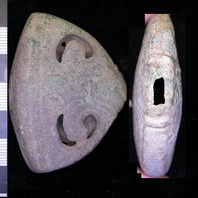
Viking Objects
Sword Pommel (LEIC-9158C3)
The pommel is probably a late development of Petersen’s type X which encompases transitional to medieval forms. Copper-alloy pommels with this basic shape are rare but not unknown in Viking Age Europe with a reasonably close example from Lough Derg, County Tipperary, in the National Museum of Ireland. The symmetrical Ringerike-style engraving is very similar to decoration commonly found on stirrup-strap mounts of the eleventh century.
Read More
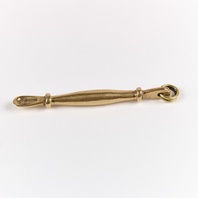
Viking Objects
Reproduction Ear Scoop
An ear scoop (or ear spoon) was a common personal hygiene tool, used for cleaning out the ears. Ear spoons are known from Roman times onwards. They are very common finds on Viking Age sites, suggesting that people took this aspect of personal hygiene very seriously.
Read More
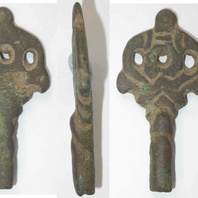
Viking Objects
Decorated Key (DENO-4259B3)
This cast copper-alloy key handle is decorated with Scandinavian-influenced designs reminiscent of the Urnes style of Viking art. Keys were not only practical items but also symbols of status. Women often carried the keys to the family’s chests of valuables. They also are often buried with keys, representing their authority in the household. See also the blog post on keys in the Viking Age.
Read More
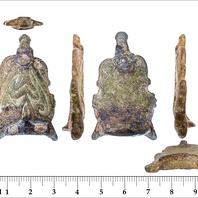
Viking Objects
Stirrup-Strap Mount (LIN-CFA7D4)
This example of an Anglo-Scandinavian cast copper-alloy stirrup-strap mount is classed as Williams Class A, Type 1A. It is decorated with a symmetrical pair of moulded beasts shown in profile in the Ringerike/Urnes style.
Read More
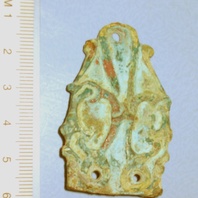
Viking Objects
Stirrup Strap Mount (NARC-C34373)
This cast copper-alloy stirrup strap mount is decorated with Ringerike style ornamentation and is classed under Williams Class A Type 1.
Read More
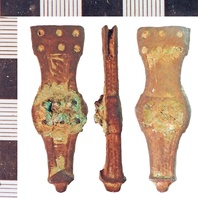
Viking Objects
Irish Strap-End (NLM-A30415)
This Irish-type strap-end has been classified as a Thomas Class F strap-end. One of the panels seems to have retained a possible reticulated interlace pattern while the inner area is decorated with six dots of inlay. Its manufacture is possibly traced to Dublin between c. 950-1050 and it is likely linked to Viking distribution of Irish artefacts. Strap-ends came in various styles and were fairly common throughout the Viking world. They were used to decorate the ends of belts and to stop them getting damaged.
Read More
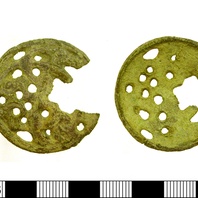
Viking Objects
Jellinge-Style Disc Brooch (LEIC-A30166)
This brooch has been classed under the Jansson Type I A1 category with decoration consisting of an openwork Jellinge design depicting an intertwined ribbon-like beast. For more information on Scandinavian jewellery in England check out our blog: Brooches, Pendants and Pins: Scandinavian Dress Accessories in England.
Read More
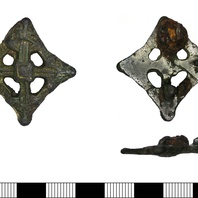
Viking Objects
Lozenge Brooch (DENO-752641)
This cast copper-alloy brooch is lozenge-shaped with openwork decoration. Brooches of this type have been found in both the Danelaw and in Scandinavia and are dated to the ninth to tenth centuries. For more information on Scandinavian jewellery in England check out our blog: Brooches, Pendants and Pins: Scandinavian Dress Accessories in England.
Read More
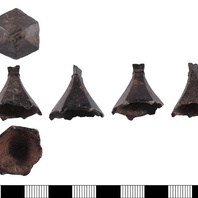
Viking Objects
Norse Bell (LIN-4509A8)
Bells of this type are described as a ‘Norse’ bell because of their association with Scandinavian sites though not much else is known about their purpose or origin. However, it seems likely that they were used as harness decorations.
Read More
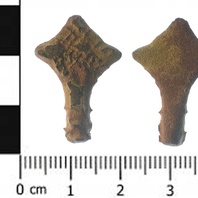
Viking Objects
Kite-Shaped Pin (SWYOR-53AEC4)
This type of kite-shape-headed pin is considered to be of Irish origin and imported through Viking activities.
Read More
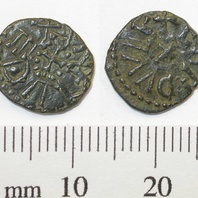
Viking Objects
Northumbrian Styca (DENO-87CE96)
This copper-alloy styca was minted by the moneyer Eardwulf in the name of King Ethelred II of Northumbria during his second reign. While Wessex and Mercia were using silver coinage as part of their monetary economy, Northumbria was using copper coins known as stycas, which may have contained trace amounts of silver. The concentration of these coins at sites such as Torksey and ARSNY suggests that they could have remained in circulation after the fall of Northumbria in 866 but were taken to the sites by the Vikings during their campaigning. they were not much use to the Vikings within their silver-based bullion economy but it is suggested that they were treated as raw material and were used as commodity money instead. The evidence for the production of copper-alloy strap-ends at Torksey and ARSNY supports this idea that the stycas were used for production.
